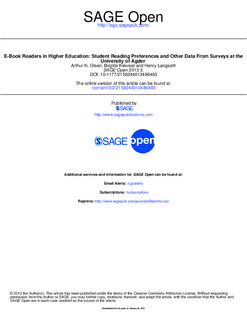| dc.description.abstract | This article reports on a research project at the University of Agder that has studied the use of e-readers as a tool for academic study. E-readers (Kindle DX and iPad) were loaded with texts from required reading lists in five courses with 94 participating students. Initially, 87 students responded to the invitation to participate in a survey, but eventually 13 of these submissions had to be removed, as the degree of completion was not sufficient. The final response rate achieved was 79%. Students were in general positive to the use of e-readers but still show a preference for print on paper as the best medium for serious academic study. When reading books, 54% preferred print, 28% a combination of print and e-reader, and finally only 11% were satisfied solely using an e-reader. The iPad scored significantly better than the Kindle DX on tasks that required active interaction with the texts such as highlighting and note taking. | |
